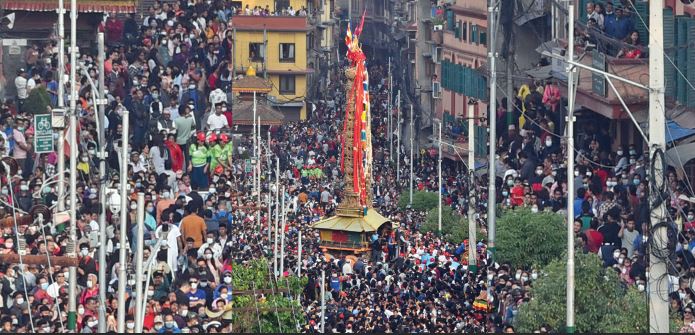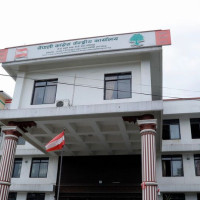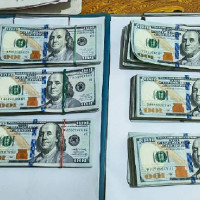- Wednesday, 14 January 2026
Minnath: The dreadlock deity who accompanies Machhindranath
Lalitpur, May 12: The longest chariot festival of Nepal that presently has the city of Patan up in joy, the Rato Machhindranath Jatra needs no introduction. The 48-foot chariot is an instantly recognisable symbol of Lalitpur and its rich culture and attracts people from all over the country. But little is known about the smaller chariot of the god popularly known as Minnath which accompanies Machhindranath along its journey through the old routes of the city.
And this is rather baffling when you consider that the festival of Minnath is older, its cult has been worshipped in Patan for longer and it belongs to the same Lokeshwor deific group as Machhindranath (Padmapani Lokeshwor). Known by many names including Chakbaha Dyo in Nepal Bhasa and Jattadhari (dreadlocks) Lokeshwor in Sanskrit and Nepali, this god residing in Tangal is the one who welcomes his famous counterpart, called Bunga Dyo and Karunamaya too, into the city, leads the way from Pulchowk to Nuga: (Sundhara) and then follows closely behind for the remaining journey.
Minnath is a god of great significance and to understand it would be to understand a crucial aspect of the Rato Machhindranath Jatra and the city of Lalitpur as a whole, said Rabindra Shakya, chairman of the Jestha Varna Mahavihar monastery development committee. Jestha Varna Mahavihar is the residence of Jattadhari Lokeshwor and Rabindra belongs to one of the many families that take care of and manage the holy monastery which has 10 Aajus (elders) and 12 members.
“To know the glory of Minnath, we must go back to a time long before ours, even before our grandfathers and their grandfathers; to the time of King Balachandra Dev’s father,” Rabindra began telling the story.
“King Balachandra’s father was a pious king who believed in serving his people and accumulating merit by appeasing the gods,” Rabindra explained. “One day, he dreamt that he died and was being taken to the land of death Yamalok.”
“On his way, he stopped at a place with many high mountains and among those mountains was a great lake. On the shores of that lake were people suffering – some were disfigured, some were limbless, some were sick and some were under great sorrow.
“In the lake was a divine figure with a head full of dreadlocked hair. He took dips in the lake’s water, got his hair fully wet and then squeezed it over the suffering souls. This cured them of their illnesses and released them from their agony.
“Seeing this, the king realised that the dreadlocked individual was a god and requested him to come to earth to care for the creatures that inhabit this planet. The person agreed and told the king to follow a bird that he would see the next morning and build a temple wherever it landed.
“Sure enough, when the king woke up the next morning, he saw a bird and followed it. The bird landed at two places. The first place it landed at for rest is where the Chakravarna Mahavihar stands today and the second place where it landed and disappeared is where the king built the Jestha Varna Mahavihar where he enshrined an image of the god he met – Jattadhari Lokeshwor, which means the dreadlocked lord of the world,” Rabindra told the story to The Rising Nepal.
A chariot festival was soon instituted in its name which was later made part of the larger Machhindranath Jatra. This was no accident and was intended to represent the inviolable relationship between life and food, Rabindra shared. “Minnath is the giver of life while Machhindranath is the giver of food. Pulling the two chariots together is an act of acknowledging that there can be no one without the other,” he said. There is yet another legend that explains why the chariot of Minnath accompanies Machhindranath during their April to July Jatra. According to tourist guide Suresh Shakya, once upon a time, Patan used to celebrate 33 chariot festivals. The 1996 research paper ‘A sketch of the history of Lalitpur with special reference to Buddhism’ by Professor David N. Gellner, professor of Social Anthropology at the University of Oxford, UK, puts this during the time of King Bir Dev and says that chariots of gods including Dhalaksha’s Loknath, Matilinagar’s Batuk Bhairav, Swotha’s Narayan, Chalakshe’s Harishankar and Kulimha’s Maheshwor were built and taken around various localities.
“However, as time passed by, people realised that 33 festivals were simply too many,” guide Suresh elucidated. “So, everyone decided to integrate all of these festivals into the Rato Machhindranath Jatra.”
He further shared, “But this incensed Chakbaha Dyo who did not feel it was appropriate for its older festival to be incorporated into the newer Machhindranath’s. This led to many unpleasant occurrences in Lalitpur. So, Minnath’s chariot was kept separate and its festival maintained.”
Whatever the legend though, Jestha Varna Mahavihar’s Rabindra stresses two things. One, Minnath has been worshipped in Patan for longer than Machhindranath. The history of Jattadhari Lokeshwor in the city can be traced back to more than 2,000 years, he says, while that of Lord Padmapani remains at around 1,500 years.
Second, Minnath and Machhindranath are equal divinities with no one being superior or inferior. Both are Bodhisattva (enlightened) Lokeshwors present for the welfare of the world. They also share the same piscine epithet. The Min in Minnath and Matsya in Matsyendranath (Machhindranath) both denote fish.
The chariot of Minnath is made completely of wood and has nine storeys. Nine is a virtuous number representing the nine planets, nine colours, nine main edible grains and other good things, Rabindra said. Furthermore, he also elucidated that Minnath was worshipped as a form of Shiva too and held both male and female forms.
“There are too many legends related to Minnath to be covered in one sitting,” Rabindra said, referring to the conversation with this scribe that had already gone on for more than 80 minutes at this point. “But there is one interesting story that has to do with King Siddhi Narsingh Malla.”
Once during Malla’s reign, the chariot of Minnath did not proceed beyond Gabahal. No matter how hard the pullers pulled, it did not move an inch. So, the king, to see what was wrong, went in the guise of an average citizen from his palace in Mangalbazaar to where the god was using a narrow alley running beside the main road. However, the king was extremely hesitant to meet Minnath and went very reluctantly. That is why the alley he used got named Mamadu (Unwilling) alley.
Upon meeting the king, Minnath promised to appear in his dream that night and in the dream, asked him to consecrate its idol in front of his royal palace. King Malla did as told and placed a Minnath statue on the tympanum above the entrance to his palace. After that, Minnath entered the city and the Jatra went smoothly.














